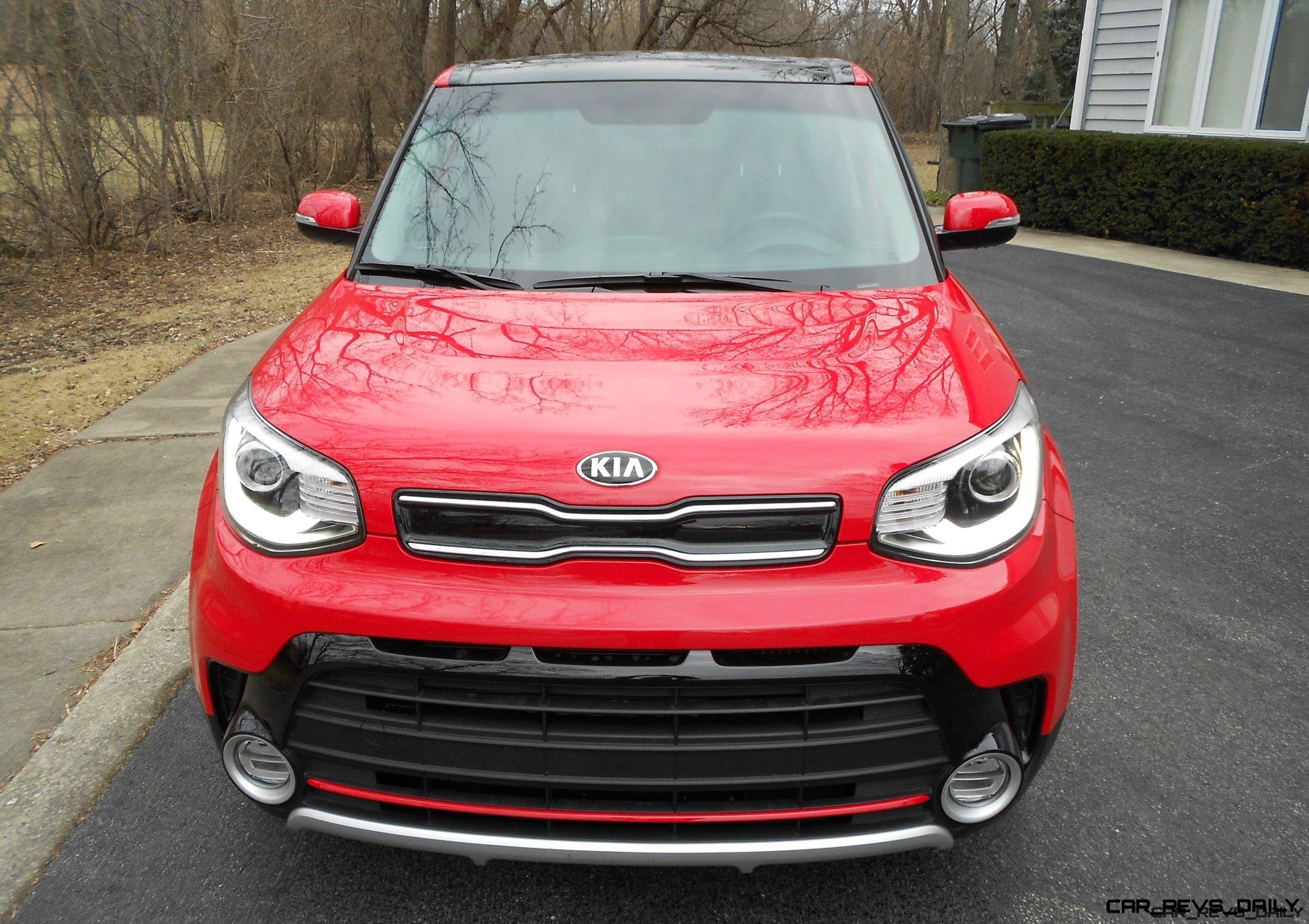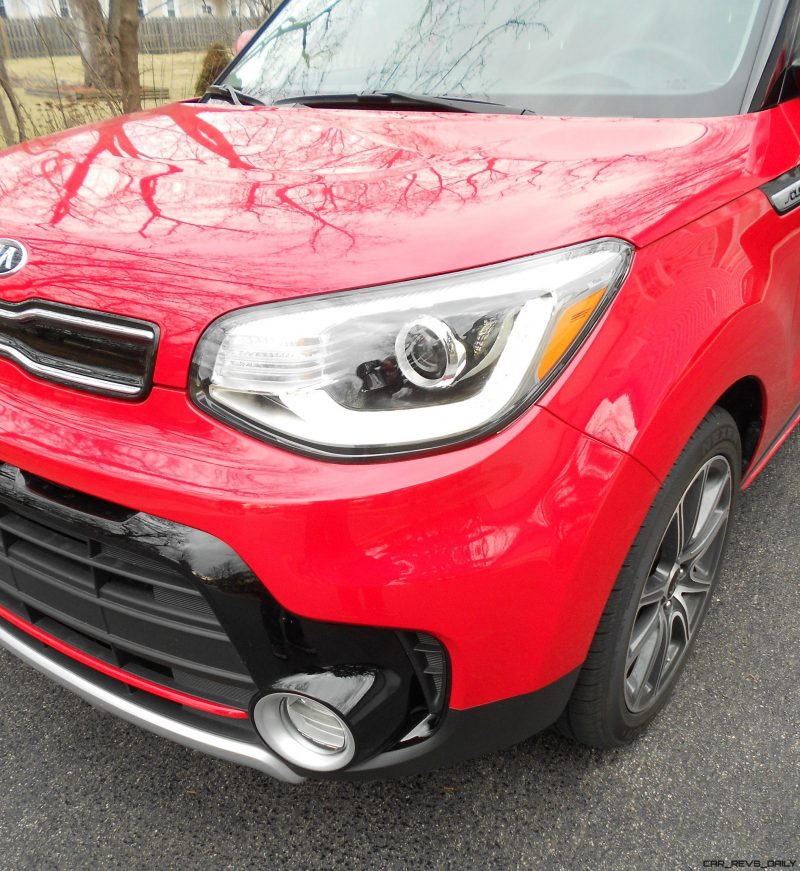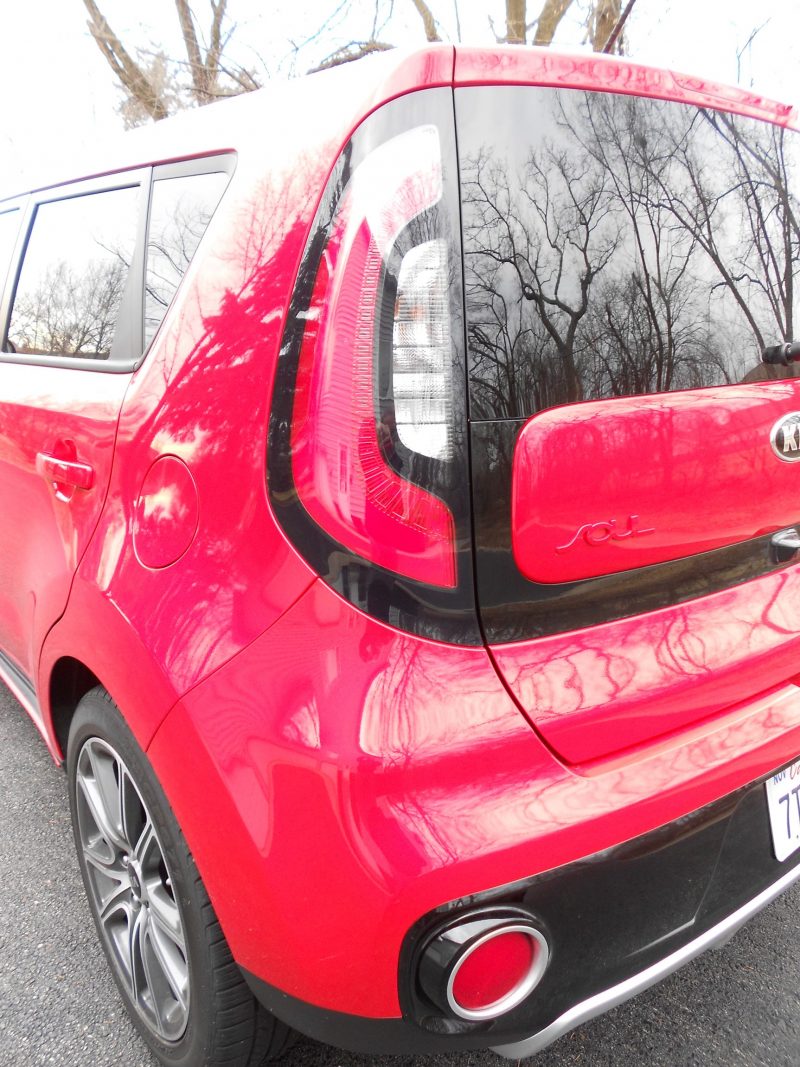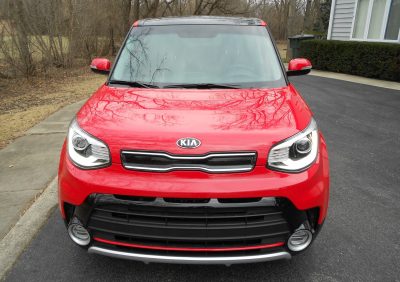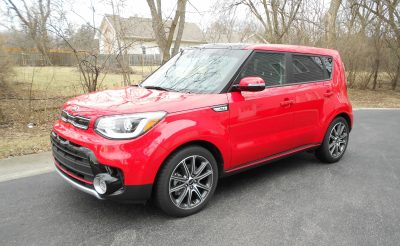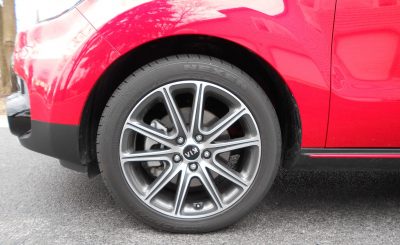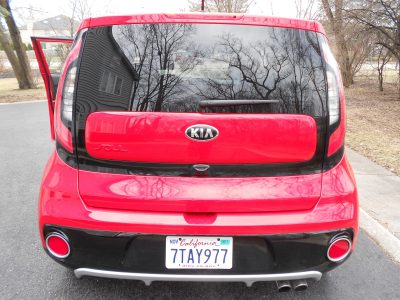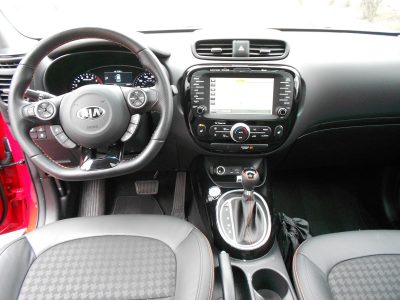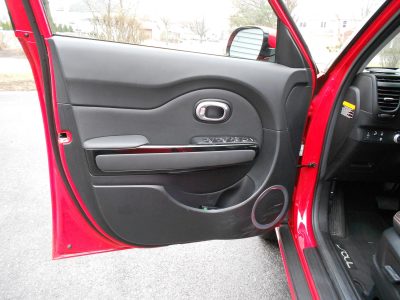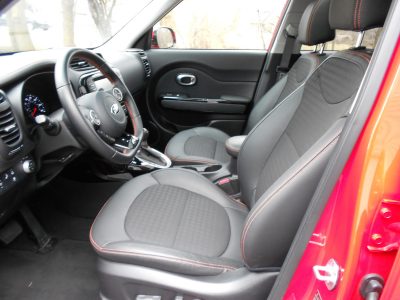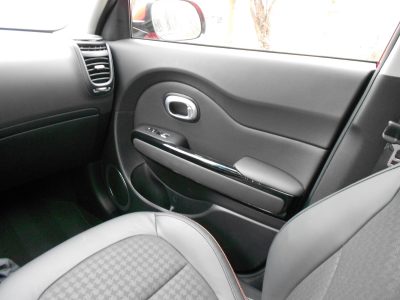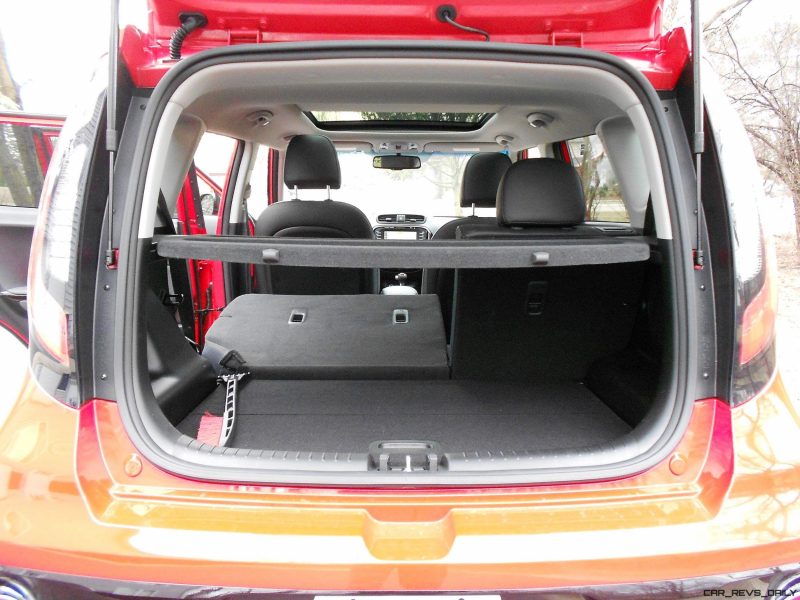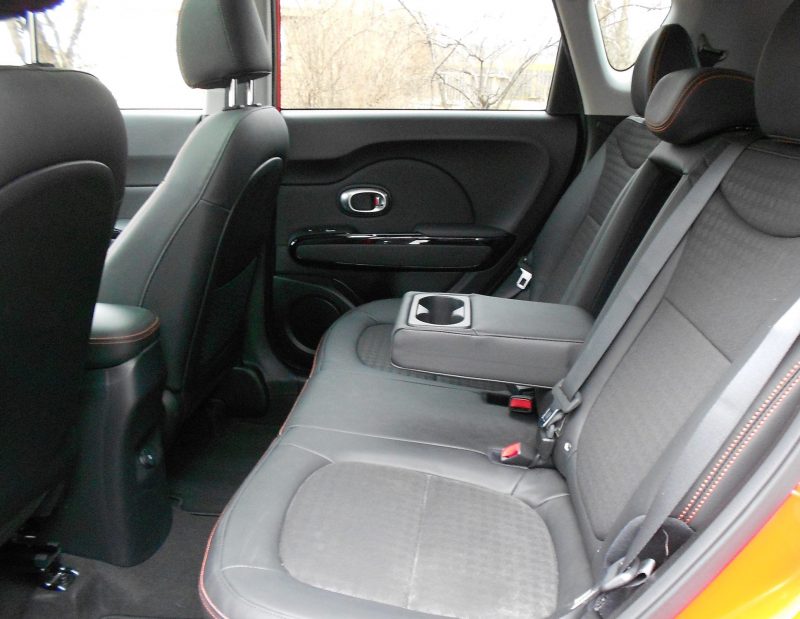Kia sells a full lineup of excellent vehicles, from small economy sedans and crossovers, to mid and full size sedans and Suv’s . They even build a luxury sedan rivaling some of the best from Japan and Europe. They have many hybrid models, and even a fully electric car. But their best-selling model is the Soul.
This compact crossover is designed to appeal to the young Millennial generation, but even this old greybeard find it an engaging vehicle that provides a lot of features, roomy interior, gas mileage economy in a fun package.
For 2017, Kia has upped the fun factor by offering a Turbo model, with the official designation of an exclamation point (!), as opposed to their Base model and mid-level model designated with a plus sign (+). For our purposes, we’ll just call it the Turbo. The engine in the Base model is a 1.6 liter inline 4, with 130 hp and 118 ft. lbs. of torque. The “Plus” model has a 2-liter engine with 161 hp and 150 ft. lbs. of torque. The new Turbo puts out a generous 201 hp and 195 ft. lbs. of torque.
That’s enough grunt to get your attention, and transforms the Soul from a cute, cuddly economy car, into a fun to drive sporty hatch. It may not breathe fire, but it cooks. It’s enough power to propel this 3,250 lb. car from zero to 60 in 7.6 seconds, and it feels even quicker. This is the same engine that powers the Kia Optima, and Hyundai Tucson and Sonata. And with Fuel Economy of 26 City and 31 mpg Highway, it beats the numbers for the 2-liter engine in the Soul Plus model.
The power comes on smoothly with a linear feel. It likes to rev, and there is great mid-range torque ready to propel the Soul for passing on a two lane road, or merging onto the highway.
The power is transmitted to the pavement by a 7-speed dual clutch manumatic transmission, with a console mounted shift lever, rather than paddle shifters. The transmission works well, and all up and down shifts are quick and smooth. The Sport mode was our preferred setting, as it adjusts the shift points higher in the rev range, improves throttle response, and makes the steering feel a bit heavier. We’d like to have a bit more steering feel and on-center feel, however.
The Soul’s Structure feels very solid, and the handling is well sorted to provide a good balance between a comfortable ride, and good handling. The basic suspension setup is McPherson struts up front, and a torsion-beam rear. It’s the same arrangement as the other Soul models, but the Turbo’s springs and dampers are tweaked for improved performance. For grip, the Turbo rides on 45-series tires and 18” rims, and has larger front discs for better stopping power than other Soul models.
The Soul soaks up bumps and potholes nicely, and offers a comfortable highway ride quality, especially for a short wheelbase car. The front wheel drive induces understeer when pushed hard in corners, but body lean is manageable, and the driver feels confident driving it aggressively in tight corners.
Styling looks like it came right from Disney’s Pixar Studios, but we find the boxy design to be cute and different. And that shape is perfect for the practicality that Kia is trying to promote. Interior room is very spacious for both front and rear passenger, and that airy feeling is only enhanced by the optional panoramic moonroof. Despite the moonroof, headroom is outstanding, so tall occupant’s won’t feel cramped or the need to hunch over. And with the rear 60/40 split seatbacks folded, there is a huge 61 cubic feet of cargo space back there, which beats almost anything in its class. Because of the boxy shape, the wind noise on the highway is more than we’d desire, but at city speeds, it is rather quiet.
The cabin is both stylish, and very well laid out. The door panels have a circular theme which is carried over from the two round stand-up stereo speakers that flank the top of the dash. Soft touch materials on the door sills, armrests and center console feel upscale. The seats are leather, with handsome cloth inserts, and are nicely bolstered and all day comfortable. The gauge package in front of the driver is easy to see and provides the driver with all the information he wants with the LED screen between the round dials. Standard items include Automatic Climate Control, power windows locks and outside mirrors, Android and Apple Carplay integration, push button start, tilt and telescope steering column, a sporty leather wrapped flat bottom steering wheel, with redundant controls, and a cargo cover. Kia’s infotainment system is easy to operate and logical, so it’s easy to get used to. Don’t bother with the voice activated feature to try to input a navigation address. Trying to speak my Illinois address into the system got me to Idaho, and Indiana, before I just used the touch screen to load me address. Unfortunately, that’s typical of most manufacturers systems. Ford is one of the few systems where the voice commands really worked well for navigation.
Our test car was outfitted with the $3,000 Technology Package, which includes a larger 8” touchscreen Nav system display. The touch screen works nicely, and I like the fact that climate controls are located beneath it, so it’s easy to adjust the HVAC without the need for going into the menus on the screen. The Tech Package also includes an excellent Harmon Kardon Premium Sound System, with speaker lights, projector low beam headlights and LED fog lights, power folding outside mirrors, power seats for both front seat passengers, heated front seats, heated rear seats, heated steering wheel, blind spot monitors, USB chargers in the center console, in addition to the one in the large cubby storage area at the base of the center stack, and LED tail lights.
Aside from the flat bottom steering wheel, the Turbo can be spotted by a red Soul badge, chrome dual exhaust tips, and red accent lines running down the sides and in front, and the 18” wheels, which fill up the wheel wells nicely.
The new Turbo model transforms an already fun, practical small car into a snappy, entertaining performer that won’t challenge a VW GTI on a race track, but it will still give the driver an exciting driving experience, without sacrificing fuel economy, or value.
The test car started at $22,650. Add $1,000 for the moonroof, $3,000 for the Tech Package, and $120 for carpeted floor mats, and you get a bottom line of $27,620 with freight. That number is very competitive with other cars in its class that are similarly equipped.
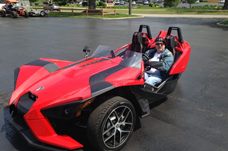
Ken “Hawkeye” Glassman has been a motor journalist for over 30 years, reviewing automobile, as well as motorcycle ride reviews and accessory reviews.
His car articles have appeared in Robb Report Magazine, Autoguide.com, Car-Revs-Daily.com and other media. His work has also appeared in Road Bike Magazine, Motorcycle Tour and Cruiser, SpeedTV.com, MotorcycleUSA.com and others.
As motorcycle columnist for The Daily Herald in suburban Chicago, the paper became the only major circulation newspaper in the country to have a separate weekly section devoted to motorcycles. Later he wrote a weekly column for Cyclefocus Magazine.

